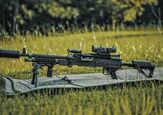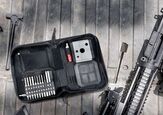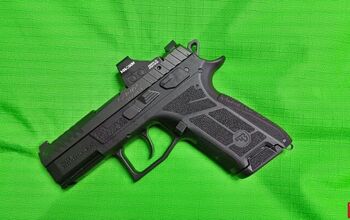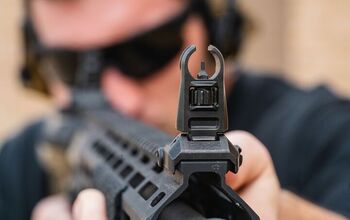The Good Nite Gear NVG50 Offers Night Vision on the Cheap(ish)

Night vision is a force multiplier, but a wallet divider. Even the relatively simple PVS-14 monocular, which has been around for around a quarter-century, costs upwards of $4,000. So, when Good Nite Gear asked me if I wanted to review the $550 NVG50 monocular, I was intrigued. When mounted to a bump helmet, it offers a workable night vision setup for under $700. But is it any good?
They sent a package that included the:
- NVG50
- GNG Tactical Night Vision Bump Helmet
- NVG50 External Battery Pack
- Wide Angle Lens Mod for NVG50
- Z06 Pic Rail Mount for NVG50
This review focuses on the NVG50 and the bump helmet.
NVG50: Tech Details
The NVG50 is a digital night vision monocular. Military Night Optical Devices (NODs) use analog image intesifier tubes, which have zero latency. The downside (other than cost) is that the image intensifier tubes are extremely sensitive to light, so you can easily damage them by exposing them to daylight. Digital NODs are more friendly for newbies, because you can expose them to bright sunlight without damaging the device.
Digital has other advantages as well, like multiple night vision modes and video capture. The NVG50 lets you record video to a microSD card in one-minute increments.
The digital lens and screen are high-resolution 2560 x 1440, also known as 1440p or quad-HD, a common resolution for computer monitors that is superior to 1080p but not as sharp as 4K. The NVG50 defaults to a slow 30 fps frame rate, but that can be bumped to 40 fps in settings, and that was one of the first things I enabled.
Being a digital monocular, the NVG50 supports magnification in 1x increments up to 4x, though I didn’t find it useful, as each increment makes the image exponentially grainier.
Another advantage of digital is that the NVG50 supports multiple color modes: Classic night vision green, black and white, blue, and a simulated color mode. As fun as the green is, I found black and white to be the most useful, especially when passive aiming. The color mode is just strange—it tries to guess the correct colors and usually gets them wrong.
The NVG50 has an IPX7 waterproof rating, which means it can be submerged in one meter of water for up to 30 minutes, but has no dust protection. It should be safe enough as long as you keep the flap covering the USB-C and microSD slots in place.
CMOS Sensor vs. Infrared
The core unit of the NVG50 is based on an ultra-low illumination CMOS image sensor. If it’s a moonlit night, you can see just fine, but you’ll struggle on darker nights. That’s why there is a built-in infrared illuminator that can brighten the picture up to 3 levels. The IR illuminator acts as a flashlight that is invisible to the naked eye, but visible in the image sensor. The IR works well, but there are some catches.
The biggest downside of the IR illuminator is that it makes aiming through a red dot impossible, because it blacks out the sight picture. There is a setting for automatic IR illumination, and I quickly disabled this once I realized this. The clear workaround for this is to attach an IR laser/illuminator to your weapon, but even the cheapest options run about $1,000.
Another downside of an IR emitter is that it gives away your position to other night vision users. For most normal people, this isn’t an issue, but it could be if you plan to use the NVG50 for some sort of competition, like airsoft or Milsim West.
The final downside of the IR emitter is that it’s incompatible with the optional fisheye lens, which expands your field of vision at the cost of blocking the emitter. Again, the solution is some sort of external infrared illuminator, like a weapon-mounted one, or an illuminator mounted to the bump helmet via its ARC mount. I’m tempted to buy a cheap IR flashlight on Amazon to experiment.
NVG 50 Power
Conveniently, the NVG50 recharges via USB-C, so in theory, any standard USB-C laptop or phone charger should work. It’s powered by two 18350 lithium batteries, but don’t expect to be able to hot-swap them in the field, as the helmet mount attaches directly over the battery cover. In my testing, I found that the batteries in the NVG50 last about four hours.
You can buy a separate extended battery pack that attaches to the helmet with hook-and-loop fasteners, but that means extra cost and weight. There’s another annoyance as well: While the NVG50 takes 18350 batteries, the battery pack takes 18650 batteries, so they’re not interchangeable. Also, the battery pack requires an external battery charger, which is a bit of a hassle.
Other than extended battery life, the battery pack offers a twofold upside: It provides a counterbalance to the weight of the NVG50 on the front of the helmet, which can cause neck strain, and it makes it possible to hotswap batteries in the field.
Bump Helmet
Bear in mind that this is a bump helmet, not a ballistic one, so you don’t want to get shot in the head while wearing this. A bump helmet is essentially a glorified tactical bicycle helmet. I’m not a helmet expert. The Goodnitegear helmet seems solid enough, but has no advertised safety ratings, like ASTM F1492-15, ANSI Z89.1, or PAS 028:2002. I did incur a couple of small head bumps while wearing it, and I can still usually correctly guess whether you’re holding up two fingers or three, but your mileage may vary.
I have a fairly large head, so I was surprised how well the helmet fit … after quite a bit of adjusting. The helmet comes with multiple hard foam pads that fit in with hook-and-loop fasteners, with a great deal of internal attachment points, so you have a lot of room to place the pads. Of course, there’s also an adjustable band, with a knob in the back to adjust the tightness. There are multiple strap attachment points.
The helmet features standard ARC rails on each side to attach things like flashlights, illuminators, and ear protection. If you don’t have ARC mounts for your ear pro, you can fit them inside the helmet by detaching the band, running the earmuffs through, and fitting the headband between the foam pads. It’s a bit awkward to don, but can be reasonably comfortable if you get everything just right. I tried it with both the Walker Razor and Howard Leight Impact Sport electronic muffs, and, predictably, the Howard Leights were much more comfortable.
Last but not least, there are bungee cords attached to the front of the helmet to help retain the monocular. Unfortunately, the NVG50 doesn’t have any sort of built-in loop to attach to, so you’ll have to rig up something.
Night Shooting with the NVG50
The NVG50 is fine for bumbling around at night and scaring the cat, but this being The Firearm Blog—can you shoot with it? As it happened, I had the perfect test subject, the new Tru-Vision SR from Meprolight, which has a night vision mode. But to explain what night vision mode does, let’s rewind a bit.
There are two kinds of aiming when wearing night vision: Passive aiming–which is aiming through an optic like a red dot—and active aiming, in which you use an IR laser to paint a target. Active aiming is much easier to use—literally point and shoot. Passive aiming has many more considerations, such as, “Can I line this clunky NVG lens up to my optic so I can actually see through it?”
Bloom is a major factor in passive aiming. Bloom is when your night vision tube or sensor gets overloaded with light. In the case of a red dot, it makes it nearly impossible to see clearly.
The night vision mode on the Tru-Vision SR dims the reticle so that it’s nearly invisible in regular light, but shows up nice and crisp in night vision. In my experience, it works pretty darn well. The bigger challenge is lining up the monocular with the sight. The Tru-Vision SR is almost too low profile to use with night vision without a riser.
Another issue is focus. The NVG50 has two focal rings: One for the display (ocular lens) and another for the external lens (objective lens). It’s common for NODs to have a shallow depth of field, which means that you have to regularly adjust the objective lens to see a crisp picture of close-up or far-away objects. Part of the trick with passive aiming is that you have to be able to clearly see a close-up object (the reticle) as well as a far-away object (the target).
The other issue is eye relief. Getting the monocular into a position where you can see through the optic without the optic kicking back and striking the monocular is tricky. During one of my night excursions, the NVG50 went blurry after firing a shot. At the time, I wasn’t sure if it was the NVG50 or my eye, but upon reviewing the footage, it was clearly the NVG50 that went blurry for a minute.
I also tested my Glock 19 with the Meprolight MPO-DF red dot attached, turned to the dimmest setting. Naturally, the pistol was easier to aim because there was less getting in the way, even if the MPO-DF doesn’t have a dedicated night vision mode.
I checked my targets in daylight. They were far from my tightest groups, but I did hit both targets.
If I took nothing else from this experience, I gained a newfound appreciation for the guys who do this stuff professionally. Juggling heavy gear on your head alongside a rifle, trying to line up a NOD with an optic just right with the correct focus and then accurately hit a target—all in the dark—is a special skill that takes a great deal of training and practice.
Cheap, but Worth the Money?
If you’re night vision curious but can’t stomach paying thousands for a headset, the NVG50 is a compelling option for tooling around in the dark and even the occasional night trips to the range. For serious operators and competitors, you’re probably better off saving your pennies for a professional setup—buy once, cry once. For the rest of us who just need to shoot the occasional raccoon, the NVG50 could be a handy thing to have on hand.

Josh is the Editor in Chief of The Fire Arm Blog, as well as All Outdoor and Outdoor Hub.
More by Josh C

























![[SHOT 2025] Miller Precision Firearms to Produce the Serbu SU-15 Upper](https://cdn-fastly.thefirearmblog.com/media/2025/01/23/21471/shot-2025-miller-precision-firearms-to-produce-mark-serbu-s-su-15-up.jpg?size=350x220)
![[SHOT 2025] Insite Armory Producing SVD Dragunov Clone In USA](https://cdn-fastly.thefirearmblog.com/media/2025/01/24/17561/shot-2025-insite-armory-produing-svd-dragunov-clone-in-usa.jpg?size=350x220)
![[SHOT 2025] KGM Suppressors’ Integrally Suppressed M2 Browning](https://cdn-fastly.thefirearmblog.com/media/2025/01/24/06341/shot-2025-kgm-suppressors-integrally-suppressed-m2-browning.jpg?size=350x220)


![[SHOT 2025] SIG Sauer’s Advanced New Machine Gun Optic - the MGL](https://cdn-fastly.thefirearmblog.com/media/2025/01/27/17081/shot-2025-sig-sauers-advanced-new-machine-gun-optic-the-mgl.jpg?size=350x220)
Comments
Join the conversation
I got one with my tax return. It's a huge step up from the sionix aurora I used to have with a decent refresh rate. The mount fits so tight it took me a few tries to get it on, but it's pretty steady. I haven't used it for any high activity purpose, I only have budget night vision to see if anyone in my AO might be using it too or communicating with buddies so I'm okay with the quality for the price. My only complaint is you need to manually work the adjustment lever to set it up or down rather than just pushing the nod up. But it came for free with the unit so, I won't nitpick. The wide angle lens mod is a nice quality of life improvement but it does add some bulk.
Hi. Thanks for the review, it definitely helps build upon the growing pool of knowledge (and popularity) surrounding this model. Can you confirm whether it is possible to run the device with USB power connected at the same time, as an alternative to using the external proprietary battery pack? Also, for anyone reading this, there are Wilcox available mounting options now on the market, which was previously a bit of a downside as only the provided mounting options were compatible with the NVG50 unlike the earlier NVG30.